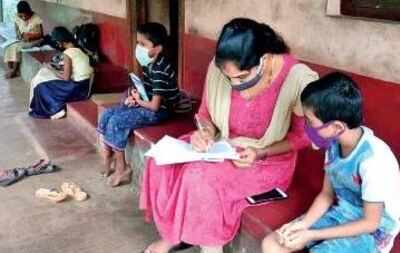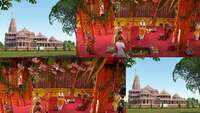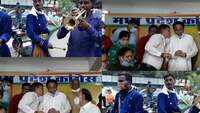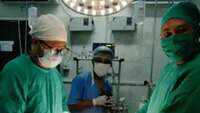
MANGALURU: With the pandemic disrupting schooling, plantations, orchards, verandahs and some public spaces have all turned into classrooms in Dakshina Kannada district. This is because a survey found that not all students have access to the internet, television or even radio and in an effort to ensure every student is on the same page as far as lessons are concerned, hundreds of government school teachers are going the extra mile.
Although the government has commenced online classes for lakhs of primary and high school students under its ‘Vidyagama’ programme, not all have access due to the digital divide. Data shows that of the 3.3 lakh students in Class 1 to 10 in Dakshina Kannada, between 40% and 50% students — regardless of whether in government, aided or unaided schools — have no access to the internet. About 7-8% of students have no TV or radio at home about 5% have no cellphones. There are 94,608 students enrolled in government schools across the district. In Belthangady taluk alone, parents of only 24,443 of the total 40,403 students have smartphones with internet facility. As many as 5,325 students have no TV or radio at home. The picture is similar in other taluks of undivided Dakshina Kannada. In Puttur BEO limits, as many as 40% parents have no smartphones with internet.
Shambhu Shankar, coordinator, BRCC, Belthangady, said students are categorised into three groups depending on access to technology: Intelligent Room (students with smartphones/PC/tablets and internet); Brilliant Room (having phones but no internet) and Genius Room (no cellphone or any gadgets).
Shankar said students in the Intelligent Room are sent notes and homework through WhatsApp on a regular basis, while those in the second category are briefed whenever their parents are at home (usually before 8am and after 6pm). “The last group, which has no access to gadgets, is the focus. Teachers play a major role in keeping them in the loop,” Shankar said.
Explaining how students in the Genius Room are reached, an official said teachers visit a cluster of students —comprising 9 or 10 — and gives them homework. The teacher visits them on alternative days.
“The interaction between teacher and student takes place in a neutral environment such as a garden, house verandah, community hall or a public space,” the official said. “Even physical education teachers are involved. They visit houses of students and spread awareness on Covid-19 as well as personal hygiene.”
In Dakshina Kannada, the digital divide is comparatively less in urban areas. In Mangaluru South limits, 66,167 of the total 68,926 primary and high school students have access to cellphones and about 54,052 have access to the internet. In Sullia, out of 20,154 students, 655 students have no cellphones and 12,350 have access to the internet.
Although the government has commenced online classes for lakhs of primary and high school students under its ‘Vidyagama’ programme, not all have access due to the digital divide. Data shows that of the 3.3 lakh students in Class 1 to 10 in Dakshina Kannada, between 40% and 50% students — regardless of whether in government, aided or unaided schools — have no access to the internet. About 7-8% of students have no TV or radio at home about 5% have no cellphones. There are 94,608 students enrolled in government schools across the district. In Belthangady taluk alone, parents of only 24,443 of the total 40,403 students have smartphones with internet facility. As many as 5,325 students have no TV or radio at home. The picture is similar in other taluks of undivided Dakshina Kannada. In Puttur BEO limits, as many as 40% parents have no smartphones with internet.
Shambhu Shankar, coordinator, BRCC, Belthangady, said students are categorised into three groups depending on access to technology: Intelligent Room (students with smartphones/PC/tablets and internet); Brilliant Room (having phones but no internet) and Genius Room (no cellphone or any gadgets).
Shankar said students in the Intelligent Room are sent notes and homework through WhatsApp on a regular basis, while those in the second category are briefed whenever their parents are at home (usually before 8am and after 6pm). “The last group, which has no access to gadgets, is the focus. Teachers play a major role in keeping them in the loop,” Shankar said.
Explaining how students in the Genius Room are reached, an official said teachers visit a cluster of students —comprising 9 or 10 — and gives them homework. The teacher visits them on alternative days.
“The interaction between teacher and student takes place in a neutral environment such as a garden, house verandah, community hall or a public space,” the official said. “Even physical education teachers are involved. They visit houses of students and spread awareness on Covid-19 as well as personal hygiene.”
In Dakshina Kannada, the digital divide is comparatively less in urban areas. In Mangaluru South limits, 66,167 of the total 68,926 primary and high school students have access to cellphones and about 54,052 have access to the internet. In Sullia, out of 20,154 students, 655 students have no cellphones and 12,350 have access to the internet.

Coronavirus outbreak
Trending Topics
LATEST VIDEOS
City
 Start of construction of Ram temple in Ayodhya marks fulfilment of key Sangh Parivar goal, RSS believes
Start of construction of Ram temple in Ayodhya marks fulfilment of key Sangh Parivar goal, RSS believes  MP Congress celebrates Ram Mandir Bhumipujan event at State Party Headquarter in Bhopal
MP Congress celebrates Ram Mandir Bhumipujan event at State Party Headquarter in Bhopal  Meghalaya: 24-kg tumour removed from woman's abdomen
Meghalaya: 24-kg tumour removed from woman's abdomen  Pending salaries for 3 months North Delhi Municipal Corporation teachers’ associations warn authorities
Pending salaries for 3 months North Delhi Municipal Corporation teachers’ associations warn authorities
More from TOI
Navbharat Times
Featured Today in Travel
Quick Links
Kerala Coronavirus Helpline NumberHaryana Coronavirus Helpline NumberUP Coronavirus Helpline NumberBareilly NewsBhopal NewsCoronavirus in DelhiCoronavirus in HyderabadCoronavirus in IndiaCoronavirus symptomsCoronavirusRajasthan Coronavirus Helpline NumberAditya ThackerayShiv SenaFire in MumbaiAP Coronavirus Helpline NumberArvind KejriwalJammu Kashmir Coronavirus Helpline NumberSrinagar encounter
Get the app



